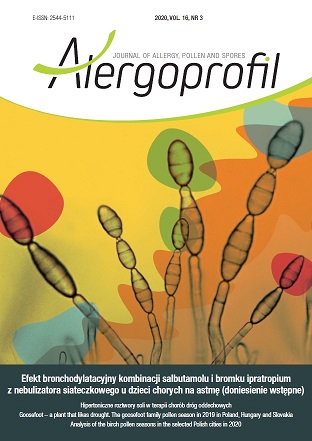Analysis of the birch pollen seasons in the selected Polish cities in 2020 Original article
Main Article Content
Abstract
The aim of the study was to compare the birch pollen seasons in selected 12 cities in Poland in 2020. The volumetric method of sampling was used to collect pollen samples. The estimation of the seasonal parameters was based on descriptive statistics. The clear differences among SPIn values at all sites were recorded. The lowest value was recorded in Bialystok (1.863 pollen/m3), whereas the highest one in Lublin (16.253 pollen/m3). The thermal conditions in the north-eastern part of Poland were the least favourable for birch pollen seasons.
Downloads
Article Details

This work is licensed under a Creative Commons Attribution-NonCommercial-NoDerivatives 4.0 International License.
Copyright: © Medical Education sp. z o.o. This is an Open Access article distributed under the terms of the Attribution-NonCommercial 4.0 International (CC BY-NC 4.0). License (https://creativecommons.org/licenses/by-nc/4.0/), allowing third parties to copy and redistribute the material in any medium or format and to remix, transform, and build upon the material, provided the original work is properly cited and states its license.
Address reprint requests to: Medical Education, Marcin Kuźma (marcin.kuzma@mededu.pl)
References
2. Seneta W, Dolatowski J. Dendrologia. Państwowe Wydawnictwo Naukowe PWN, Warszawa 2007.
3. Zając A, Zając M (ed). Atlas rozmieszczenia roślin naczyniowych w Polsce: Dodatek. Distribution Atlas of Vascular Plants in Poland: Appendix. Instytut Botaniki Uniwersytetu Jagiellońskiego, Kraków 2019.
4. Biedermann T, Winther L, Till SJ et al. Birch pollen allergy in Europe. Allergy. 2019; 74: 1237-40.
5. D’Amato D, Cecchi L, Bonini S et al. Allergenic pollen and pollen allergy in Europe. Allergy. 2007; 62(9): 976-90.
6. Myszkowska D. Prediction of the birch pollen season characteristics in Cracow, Poland using and 18-year data series. Aerobiologia. 2013, 29: 31-44.
7. Weryszko-Chmielewska E. Ziarna pyłku i zarodniki grzybów w powietrzu różnych regionów Polski. Polskie Towarzystwo Botaniczne. Norbertinum, Lublin–Warszawa 2014.
8. Kubik-Komar A, Piotrowska-Weryszko K, Weryszko-Chmielewska E et al. A study on the spatial and temporal variability in airborne Betula pollen concentration in five cities in Poland using multivariate analyses. Sci Total Environ. 2019; 660: 1070-8.
9. Małolepszy J, Liebhart J, Wojtyniak B et al. Występowanie chorób alergicznych w Polsce. Alerg Astma Immunol. 2000; 5(2): 163-9.
10. Samoliński B, Sybilski A, Raciborski F et al. Prevalence of rhinitis in Polish population according to the ECAP (Epidemiology of Allergic Disorders in Poland) study. Otolaryngol Pol. 2009; 63(4): 324-30.
11. Małolepszy J, Liebhart J, Wojtyniak B et al. Występowanie chorób alergicznych w Polsce. Alerg Astma Immunol. 2000; 5(2): 163-9.
12. Myszkowska D, Piotrowicz K. Birch (Betula L.) pollen seasons in Cracow in 1991–2008 associated to the meteorological conditions. Acta Agrobotanica. 2009; 62(2): 67-75.
13. Moverare R, Westritschnig K, Svensson M et al. Different IgE reactivity profiles in birch pollen‐sensitive patients from six European populations revealed by recombinant allergens: an imprint of local sensitization. Int Arch Allergy Immunol. 2019; 128(4): 325‐35.
14. Matricardi PM, Kleine-Tebbe J, Jürgen Hoffmann H (ed) et al. Molecular allergology. User’s guide. The European Academy of Allergy and Clinical Immunology (EAACI). John Wiley & Sons, Zurich 2016.
15. Galán C, Smith M, Thibaudon M et al. Pollen monitoring: Minimum Requirements and Reproducibility of Analysis. Aerobiologia. 2014; 30: 385-95.
16. Galán C, Ariatti A, Bonini M et al. Recommended terminology for aerobiological studies. Aerobiologia. 2017; 33(3): 293-5.
17. Piotrowska-Weryszko K, Weryszko-Chmielewska E, Dmitruk M et al. The analysis of Betula pollen season in Poland in 2019. Alergoprofil. 2019; 15(3): 10-5.
18. Dahl A, Galan C, Hajkova L. The onset, course and intensity of the pollen season. In: Sofiev M, Bergmann K-Ch (ed). Allergenic pollen. A review of the production, release, distribution and health impacts. Dordrecht: Springer. 2013; 29-70.
19. Myszkowska D. Predicting tree pollen season start dates using thermal conditions. Aerobiologia. 2014; 30(3): 307-21.
20. Laadi K. Regional variations in the pollen season of Betula in Burgundy: Two models for predicting the start of the pollination. Aerobiologia. 2001; 17: 247-54.
21. Linkosalo T, Ranta H, Oksanen A et al. A double-threshold temperature sum model for predicting the flowering duration and relative intensity of Betula pendula and B. pubescens. Agr Forest Meteorol. 2010; 150: 1579-784.
22. https://klimat.imgw.pl/pl/biuletyn-monitoring/#2020/03.
23. Borycka K, Ortyl B, Kasprzyk I. Temporal variations and spatial differentiation inthe black alder and silver birch pollination pattern – the impact of local climate or something more? Agric For Meteorol. 2017; 247: 65-78.
24. Bogawski P, Borycka K, Grewling Ł et al. Detecting distant sources of airborne pollen for Poland: Integrating back-trajectory and dispersion modelling with a satellite-based phenology. Sci Total Environ. 2019; 689: 109-25.
25. Myszkowska D, Jenner B, Puc M et al. Spatial variations in dynamics of Alnus and Corylus pollen seasons in Poland. Aerobiologia. 2010; 26(3): 209-21.

